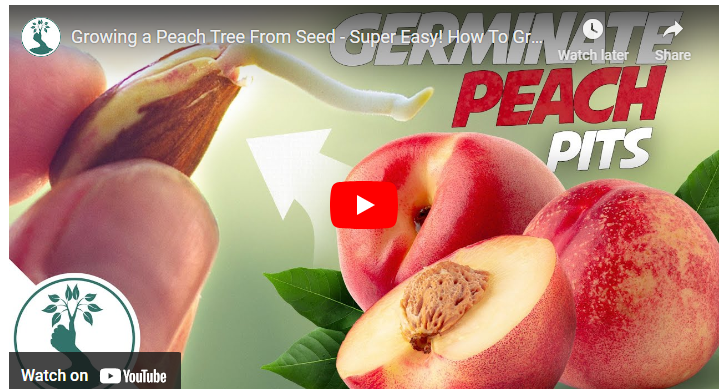If you’ve ever enjoyed the sweet juiciness of a peach and wondered how to grow one from a seed, you’re in the right place. Sprouting a peach seed can be a rewarding experience that allows you to witness the miracle of nature firsthand. In this step-by-step guide, we’ll walk you through the process of sprouting a peach seed and nurturing it into a healthy sapling.
To sprout a peach seed, first clean and dry the seed, then place it in a moist paper towel or container with damp peat moss, and keep it in a cool, dark location for several weeks until roots start to form, after which it can be transplanted into a pot with well-draining soil and placed in a sunny spot to continue growing into a peach tree.
How to Sprout a Peach Seed Step by Step Guide
Step 1: Gathering Materials
Before you begin, gather the following materials:
- Fresh peach seed
- Paper towel
- Sealable plastic bag
- Small container
- Potting soil
- Pots or seedling trays
- Water
Step 2: Preparing the Peach Seed
Start by removing the peach seed from the fruit. Rinse off any remaining flesh gently under running water. Avoid using soap or any chemicals.
Step 3: Soaking the Peach Seed
Place the peach seed on a damp paper towel and fold the towel over it. Put the towel with the seed into a sealable plastic bag, leaving it slightly open for airflow. Keep the bag in a warm location for about 24 hours. This process helps soften the hard seed coat and prepares it for germination.
Step 4: Planting the Peach Seed
After soaking, remove the peach seed from the plastic bag and gently unwrap it from the paper towel. Fill a small container with moist potting soil, leaving about an inch of space from the top. Plant the peach seed vertically, with the pointed end facing downwards, about an inch deep into the soil.
Step 5: Providing the Right Environment
Place the planted seed in a warm and well-lit area, such as a sunny windowsill. Peach seeds require a consistent temperature between 65°F and 75°F (18°C to 24°C) for optimal germination. Ensure the seed receives indirect sunlight for 6 to 8 hours a day.
Step 6: Watering and Caring for the Sprout
Keep the soil moist but not waterlogged. Water the seedling gently whenever the top inch of soil feels dry to the touch. Avoid overwatering, as it may lead to root rot. Mist the leaves occasionally to increase humidity around the sprout.
Step 7: Protecting the Sprout
To protect the young sprout from extreme temperatures, consider using a small greenhouse or a plastic dome cover. This will create a more controlled and favorable environment for the seedling’s growth.
Step 8: Transplanting the Sprout
Once the sprout develops a strong root system and reaches a height of about 6 inches, it’s time to transplant it into a larger pot or directly into the ground. Ensure the new container or planting location provides adequate space for the peach tree’s future growth.
Step 9: Monitoring Growth
Regularly monitor the growth of your peach tree. Ensure it receives enough sunlight, water, and nutrients. Fertilize the tree with a balanced fertilizer during the growing season. Prune any damaged or diseased branches to maintain the tree’s health.
Step 10: Troubleshooting Common Issues
Peach trees may face challenges like pests, diseases, or nutrient deficiencies. Keep an eye out for signs of trouble, such as yellowing leaves, pests on the foliage, or stunted growth. Take appropriate measures like applying organic pest control, improving soil fertility, or seeking expert advice when needed.
Step 11: Harvesting the Peach Tree
With proper care and patience, your peach tree will start bearing fruit in approximately 3 to 4 years. The time may vary depending on the peach variety and growing conditions. Harvest the peaches when they are fully ripe by gently twisting them off the tree. Enjoy the sweet reward of your efforts!
Can I sprout a peach seed from any peach variety?
Yes, you can sprout a peach seed from most peach varieties available in your local grocery store. However, keep in mind that the resulting tree may not produce peaches with the exact characteristics of the parent fruit.
How long does it take for a peach seed to sprout?
After following the soaking process, a peach seed typically takes 2 to 4 weeks to sprout. However, germination time may vary depending on various factors such as temperature and seed quality.
Can I plant the sprouted peach seed directly into the ground?
It’s best to start the sprouted peach seed in a pot or container before transplanting it into the ground. This allows you to provide more controlled growing conditions and ensure the sapling’s survival.
Can I grow a peach tree from a pit bought at the grocery store?
Yes, you can grow a peach tree from a pit bought at the grocery store. However, keep in mind that store-bought peaches are often treated with chemicals, which may affect germination and growth. Opting for organic or locally sourced peaches is recommended.
How often should I water the sprouted peach seedling?
Water the peach seedling whenever the top inch of soil feels dry. Aim for consistent moisture without overwatering. Overwatering can lead to root rot, so it’s important to strike the right balance.
Conclusion
Growing a peach tree from a seed is a gratifying experience that allows you to witness the beauty of nature’s growth process. By following these step-by-step instructions, you can sprout a peach seed and nurture it into a healthy tree that will reward you with delicious, homegrown peaches. Enjoy the journey and the fruits of your labor!




